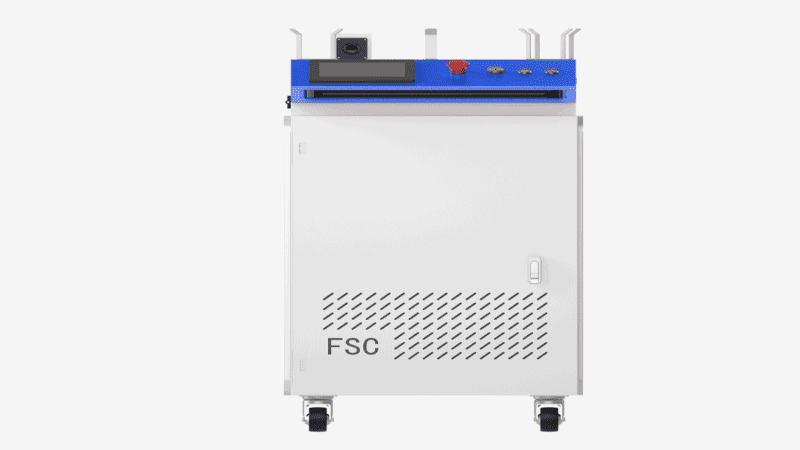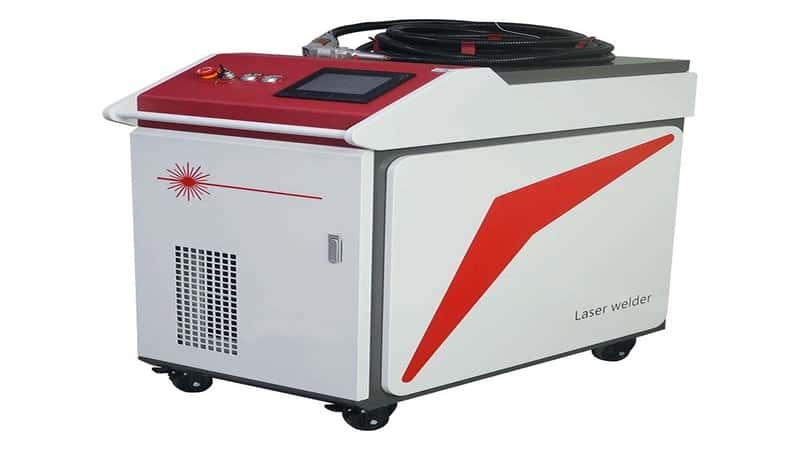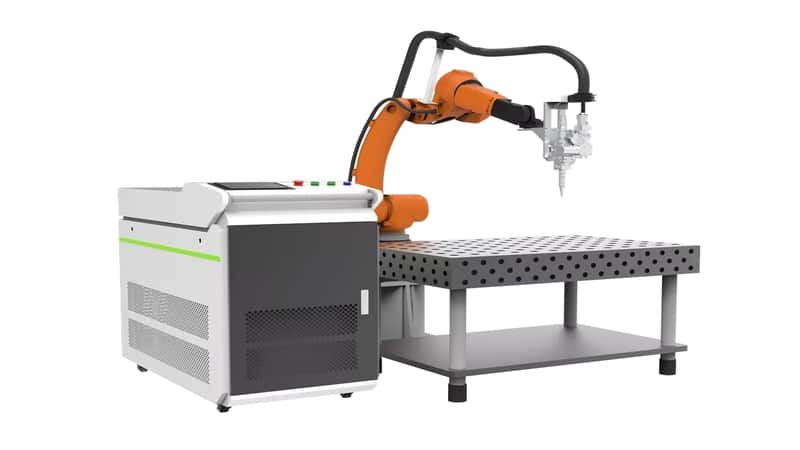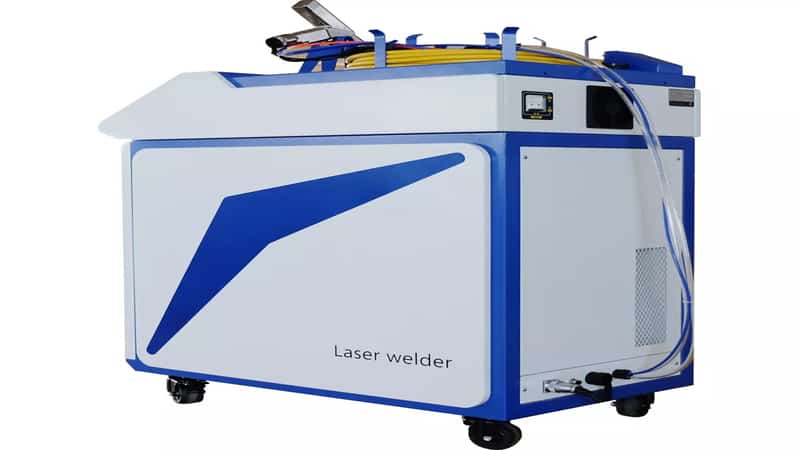In today’s increasingly competitive market, staying at the top of your industry requires reduced production costs and high-volume productions with improved quality and increased welding automation, none of which can be easily achieved using traditional techniques.
Welding machines have become the solution for advanced manufacturing across many industries, adding efficiency to organizations and helping to overcome production challenges. But with various types of welding machines available in the market, how do you ascertain which suits your business and its production needs?
Hence, this post will compare two such machines, fiber laser welding machines and welding robots, discussing their advantages and disadvantages and how to select which best suits your needs.
What Is a Fiber Laser Welding Machine?

A fiber laser welding machine is a type of laser welding system that uses a high-powered, focused laser beam to fuse mostly metallic materials together. Fiber laser welding can be in the form of handheld or CNC laser welding technology. The former is automated and highly precise, while the latter is more popular and affordable.
Nevertheless, both fiber laser processes allow precision and increased welding quality in industrial applications.
Generally, fiber laser welding machines work by using a glass or plastic optical fiber cable doped with energy-amplifying elements, such as ytterbium, neodymium, or erbium, to focus and guide the fiber laser beam along the desired work path.
The laser beam, at high energy and density, is reflected through mirrors and lenses in the welding head and melts and welds materials together, enabling a fast and precise welding process while minimizing heat-affected area and distortion.
Advantages of Using a Fiber Laser Welding Machine
Here are some benefits you will enjoy when using this welding method:
Precision
Fiber laser welding systems use highly focused and concentrated laser beams that allow strict control over the weld output and low heat-affected zone, resulting in clean and precise welding. This feature also allows this technology to be used on small, delicate materials.
Automation
These machines can be fed designs and work paths through digital commands making it easy to automate the welding process and achieve high-quality welds without errors. This also allows for a very repeatable process.
High Speed
Unlike traditional welding methods like Plasma Arc Welding, fiber laser welding speed is significantly higher due to rapid heating and melting, which allows for reduced production time and increased output. This makes this system ideal for high-volume welding productions.
Versatility and Flexibility
Fiber laser welding machines are widely used in several industries and applied to various sizes and thicknesses of materials. They are also easily maneuverable, accessing areas that are difficult to reach and fostering complex welding techniques.
Reduced Maintenance
Due to the absence of moving parts, fiber laser machines operate with a non-contact system, reducing the risk of wear and tear or downtime and increasing their operational lifespan. Their state-of-the-art design eliminates the need for constant replacements of parts, rendering them virtually maintenance-free systems.
Disadvantages of a Fiber Laser Welding Machine

Despite its many benefits, fiber laser welding technology still has some shortcomings.
Initial Cost
The initial cost of the machine can be pretty high. These systems are more expensive to purchase and install than traditional welding methods. Furthermore, the additional cost of maintenance, repairs, and training of employees to use them can be expensive, especially if you aren’t into high-volume productions.
Also, these fiber lasers require additional components, such as the welding head, cooling system, and fiber optic cable, which can add to the cost significantly.
Contamination
The optical components of fiber lasers are highly sensitive to contamination from dust and particles from the environment, leading to overheating and performance reduction. This can also damage the laser power and laser source, reducing welding integrity.
However, this can be prevented by regularly cleaning and maintaining the machine to ensure optimal operation.
Operator Training and Specialization
Fiber laser machines require specific skill and expertise as the setup of mechanisms, such as welding speed and power, requires training to achieve the desired results. Also, specialized knowledge s required for programming and automation of the machine to facilitate complex setups.
What Is a Welding Robot?

Welding robots are automated machines that use a robotic arm to conduct welding operations. Compared to traditional welding techniques, robotic welding is a very advanced form of welding; however, it still requires human welders to program and, sometimes, control the laser welding robots.
Robotic laser welding technology can be adapted to a wide range of welding processes, including gas tungsten arc welding, resistance spot welding, plasma arc welding, Tungsten Inert Gas (TIG), Metal inert Gas (MIG), and laser welding.
Like spot welding robots, robotic welding uses a robot arm controlled by a computerized system comprising several joints for motion and flexibility to carry out complex welding processes and adapt to your preferred welding solution.
Aside from the robotic arm, the welding robot is also fitted with a welding gun to deliver arc welding to the material and a wire feeder feeding the wire into the arc for welding.
Finally, the welding robot contains shielding gas supplied to the work area to prevent oxidation and contamination during welding.
Advantages of Using a Welding Robot
Here are some reasons why you should throw out traditional welding techniques and incorporate a laser welding robot in your production:
Excellent Weld Quality
Welding robots perform tasks according to the paths and parameters they are programmed with, allowing for precision and accuracy, minimizing errors or defects, and improving weld quality. Due to the accuracy of these welding robots, there would be no need for corrections or reworks, increasing reliability and customer satisfaction.
Increased Welding Productivity
Unlike humans, welding robots can work at high speed while still maintaining the same high-quality weld. They also don’t get fatigued, take breaks, or experience downtime, allowing you to increase your output with shorter production cycles.
These robots can be easily reprogrammed and integrated into other robotic systems to scale your manufacturing capacity and handle diverse welding requirements.
Safer Working Conditions
Workplace safety is a significant concern in the manufacturing industry. However, these robots can perform complex, high-risk tasks in hazardous conditions, improving the safety of human operators. The systems are also equipped with safety control to protect the equipment.
Consistency
Welding robots are fitted with data-logging mechanisms to collect and analyze data. This ensures high repeatability, allowing them to maintain consistent weld quality, high reliability, and traceability of the welding parameters.

Disadvantages of Using a Welding Robot
Although welding robots have many advantages, there are a few setbacks to note.
Initial Cost
Purchasing and installing a robotic welding system can incur high costs as the robot has additional equipment, programming, and safety systems that must be acquired together. It is difficult to reconcile such a considerable investment if you’re a small business or only do specialized productions.
Technical Expertise
Operating personnel must-have technical expertise in programming, maintenance, and troubleshooting to operate a welding robot efficiently. Some businesses might find employing or training personnel to operate and maintain the robotic systems difficult.
Reduced Flexibility for Small, Customized Tasks
Robotic welding systems are best suited for high-volume, repetitive welding tasks. Hence, they might not be suited for small welding jobs with frequent customizations and changes. Constant reprogramming will be required, which can be time-consuming, reduce productivity, and have cost implications.
What Are the Differences Between Fiber Laser Welding Machines and Welding Robots?
Work Volume
Fiber Laser welding machines are Ideal for both high and low-volume welding tasks.
Welding Robots are mostly ideal for high-volume welding tasks requiring repetition and consistency.
Automation
Fiber Laser welding machines might require manual control by human operators.
Welding Robots have a higher level of automation and can operate continuously without human operators.
Consistency in Precision
Fiber Laser welding machines’ precision is mainly based on the skill and expertise of the operator.
Welding Robots offer high precision and consistency due to programming and their advanced control systems.
Cost
Fiber Laser welding machines’ cost is based on power and features, but they have a lower initial cost than robot welders.
Welding Robots have a higher initial cost due to the complexity of their advanced system.
Flexibility
Fiber Laser welding machines need more specialized laser welding operations.
Welding Robots can be applied to various welding tasks and production demands.

How to Choose the One That Suits You?
When deciding which welding machine suits you and your manufacturing requirements, you must consider a few factors. Some of these include cost-effectiveness in relation to the size of your business and volume of your production, the level of automation desired, and operation needs.
Although both welding technologies offer numerous benefits, you must evaluate your business’s specific needs, goals, and limitations of the welding technique to make an informed decision.
Conclusion
Fiber laser welding machines and robots have revolutionized the industrial welding process, allowing you to automate and optimize your production cycle time and produce higher-strength welds.
Nevertheless, depending on your specific welding requirement, each technology can offer unique benefits. But before selecting one, consider your organization’s budget, size, and production volume to ensure you choose one that will maximize your profit in the long run.
You can visit our website for further information and assistance on fiber laser welding machines and welding robots.





